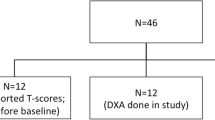Abstract
In this cross-sectional study, bone mass and muscle strength of the thigh were investigated in 16 Caucasian female cross-country skiers, age 16.2 ± 0.3 years, that had been ski-training for 6.4 ± 1.8 years (range 3–9 years) and were now training for 6.3 ± 2.4 hours/week (range 3–12 hours). They were compared with 16 nonactive females, age 16.4 ± 0.7 years. The groups were matched according to age, weight, height, and pubertal status. Areal bone mineral density (BMD) was measured using dual energy X-ray absorptiometry, in the total body, head, both total humerus and humerus diaphyses, spine, and in the right femoral neck, greater trochanter, femoral diaphysis, distal femur, proximal tibia, and tibia diaphysis. Bone mineral apparent density (BMAD) was also calculated for the femoral neck and humerus diaphyses. Isokinetic muscle strength of the quadricep and hamstring muscles was measured in an isokinetic dynamometer. Compared with the controls, the cross-country skiing group had significantly higher BMD in the right whole humerus (6.9%), left whole humerus (9.2%), left humerus diaphysis (8.1%), femoral neck (8.9%), greater trochanter (9.3%), femur diaphysis (7.6%), and BMAD of the femoral neck (+19.4%). In the nonactive group there were significant side-to-side differences in BMD of the whole humeri, humerus diaphyses, and BMAD of the humerus diaphyses (3.1%, 5.4%, and 8.8% higher in the right arm, respectively). No such differences were found in the cross-country skiing group. Lean body mass was significantly higher in the cross-country skiers (21.7%), and fat mass (−25.5%) and body fat percent (−28.0%) were significantly lower compared with the nonactive group. There were, however, no significant differences in concentric peak torque of the thigh muscles between the two groups. Stepwise regression analyses revealed that BMI was the best predictor of several sites in the nonactive group. In the cross-country group, on the other hand, muscle strength was a strong predictor of BMD, both at adjacent and more distant BMD sites. In conclusion, it seems that this type of endurance training is associated with a site-specific higher bone mass that may be associated with the type and magnitude of loading during off-season and during the main sports activity, cross-country skiing.
Similar content being viewed by others

Author information
Authors and Affiliations
Additional information
Received: 4 May 1998 / Accepted: 8 March 2000
Rights and permissions
About this article
Cite this article
Pettersson, U., Alfredson, H., Nordström, P. et al. Bone Mass in Female Cross-Country Skiers: Relationship Between Muscle Strength and Different BMD Sites. Calcif Tissue Int 67, 199–206 (2000). https://doi.org/10.1007/s002230001117
Published:
Issue Date:
DOI: https://doi.org/10.1007/s002230001117



